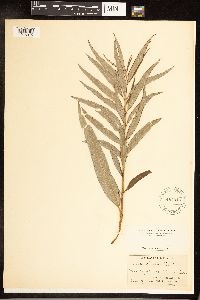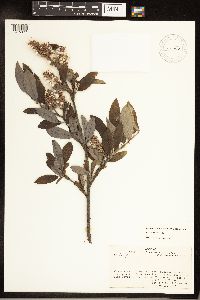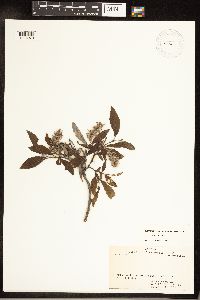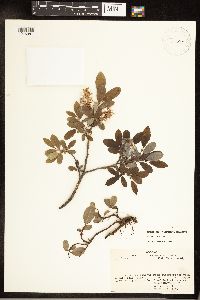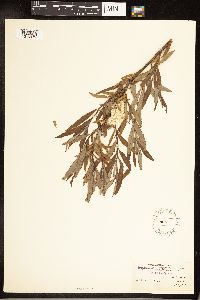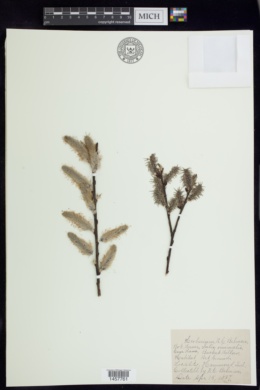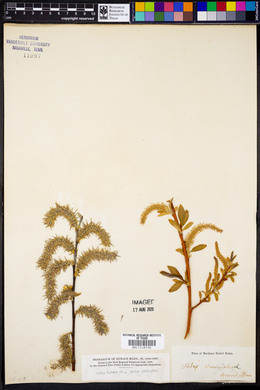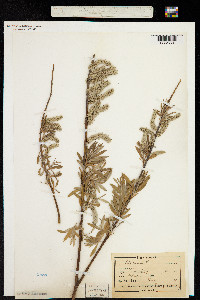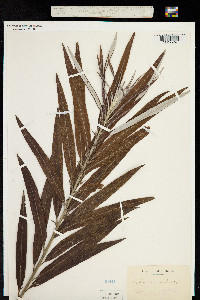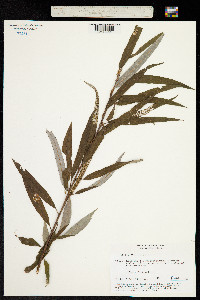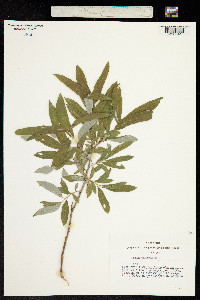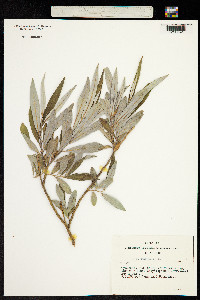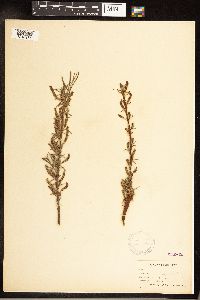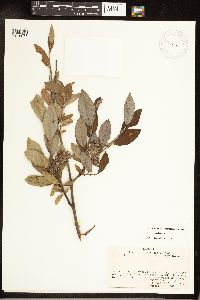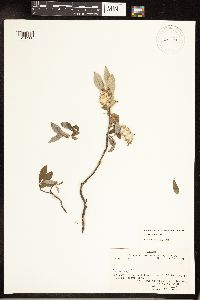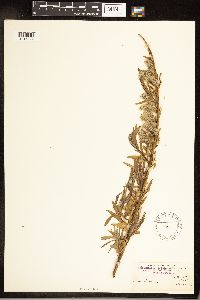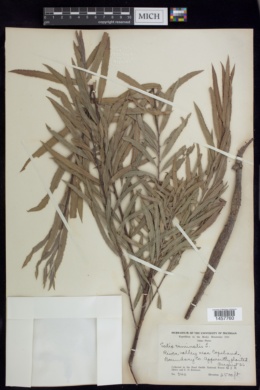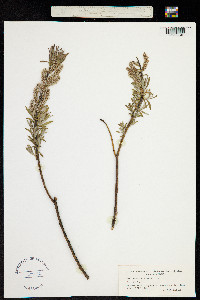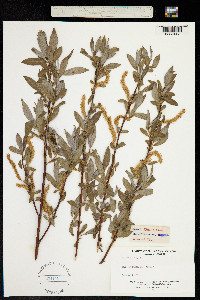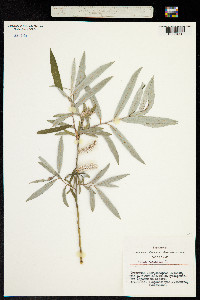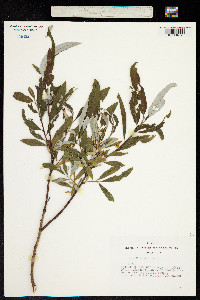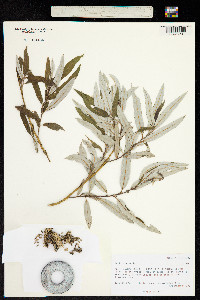Salix viminalis
|
|
|
|
Family: Salicaceae
Basket Willow
|
Stems: branches yellow-brown, gray-brown, or yellowish, not glaucous, glabrous or puberulent; branchlets yellow-brown or yellowish (sometimes color obscured by hairs), glabrous, densely to sparsely villous, velvety, or puberulent. Leaves: stipules (not adnate to petioles), rudimentary or absent on early ones, (late ones sometimes brownish, linear, 5.4-10.4 mm), apex acuminate; petiole shallowly grooved adaxially, 4-13 mm, villous, puberulent, or velvety adaxially; largest medial blade linear, lorate, narrowly oblong, or narrowly elliptic, 53-130 × 5-33 mm, base cuneate, margins strongly revolute, sinuate or apparently entire, (glands epilaminal), apex acuminate, acute, or convex, abaxial surface apparently glaucous (obscured by hairs), densely short-silky, woolly, or tomentose, (midribs prominent, yellowish, and hairy), hairs appressed, spreading or erect, straight or wavy, adaxial dull or slightly glossy, sparsely or moderately densely pubescent, hairs gray; proximal blade margins entire; juvenile blade yellowish green, very densely tomentose or short-silky abaxially, hairs white. Catkins flowering just before or as leaves emerge; staminate stout, 24-48 mm, flowering branchlet 0-2 mm; pistillate densely flowered, 23-55 mm, flowering branchlet 0-6 mm; floral bract brown or tawny, 1.6-2.2 mm, apex convex or rounded, abaxially hairy, hairs straight. Staminate flowers: adaxial nectary narrowly oblong or oblong, 0.6-1.5 mm; filaments distinct; anthers purple turning yellow, ellipsoid to shortly cylindrical, 0.6-0.8 mm. Pistillate flowers: adaxial nectary narrowly oblong or oblong, 0.9-1.4 mm; ovary pyriform, beak gradually tapering to styles; ovules 12-18 per ovary; styles 0.6-1.8 mm. Capsules 4-6 mm. 2n = 38. Flowering Apr-early May. Sandy, open woods, cobble rivershores, lake margins, and roadsides; 0-300 m; introduced; N.B., Nfld. and Labr. (Nfld.), N.S., Ont., P.E.I., Que.; Conn., Ind., Iowa, Maine, Mass., N.J., N.Y., Ohio, R.I., Vt.; Europe. Salix ×smithiana (S. caprea × S. viminalis) is distinguished from S. viminalis by having leaf blades usually broad, 2.8-4.9(-6.4) times as long as wide, stipes 0.9-2 mm, ovaries short-silky, branches ± brittle at base, and petioles flat to convex adaxially; S. viminalis has leaf blades usually very narrow, 4.7-13.7 times as long as wide, stipes 0.1-0.5 mm, ovaries long-silky, branches flexible at base, and petioles shallowly grooved adaxially. See Salix ×smithiana [p. 132] and 86. S. pellita for further comparative descriptions.
Shrub or small tree to 8 m tall, trunk diameter to 15 cm Leaves: alternate, on 4 - 12 mm long, hairy leafstalks, dull dark green above, grayish white beneath, 7 - 15 cm long, 4 - 16 mm wide, narrowly lance-shaped to lance-shaped with a tapering base and long-pointed tip (broadest below the middle), revolute (rolled downward along the margins), and densely silky-hairy on the lower surface. Flowers: either male or female, borne on separate trees (dioecious) in nearly stalkless, hairy, egg-shaped to cylindrical catkins. Female catkin to 2.5 cm long with brown or blackish scales. Ovary very woolly. Male catkin 2 - 4 cm long with brown or blackish scales. Stamens two, long, with yellow anthers. Fruit: a capsule, in 3 - 6 cm long clusters, stalkless, light brown, 6 - 15 mm long, flask-shaped, and finely hairy. Seeds have long, white, silky hairs attached. Bark: gray, smooth, or slightly fissured. Twigs: long, slender, flexible, greenish, densely hairy, becoming hairless and shiny. Buds: yellow to reddish brown, egg-shaped, hairy, becoming hairless. Form: narrow or somewhat rounded with long, upright, wand-like branches. Similar species: In the Chicago Region, Salix viminalis differs from all other willows by having lance-shaped, revolute leaves that are silky-hairy beneath and not distinctly toothed. Flowering: early spring, before the leaves Habitat and ecology: Introduced from Eurasia. Found in moist soils and spreading from cultivation, usually near homes and towns. Occurence in the Chicago region: non-native Notes: It was brought to North America for basketmaking, wickerware, and for cultivation as an ornamental. Etymology: Salix is the Latin word for willow. Viminalis means "with long slender shoots, like osiers." Author: The Morton Arboretum Few-stemmed shrub or tree to 15 m; twigs slender, yellowish to reddish- brown, puberulent to glabrous; stipules mostly wanting, or lance-linear and to 9 mm; petioles to 1 cm; lvs lance- linear, 5-12(-17) cm נ5-15(-20) mm, long-acuminate, revolute, entire or shallowly undulate, dull green and puberulent with impressed veins above, densely short-sericeous with yellow midrib beneath, the primary lateral veins numerous, wide-angled; catkins with the lvs, subsessile, 2-6 cm, mostly naked; scales 1.5-2.5 mm, black, thinly villous; stamens 2; frs lanceolate, 4-6 mm, subsessile, densely short-sericeous; style 0.7-1.2 mm; 2n=38. Native of Eurasia, occasionally escaped from cult. in our range. A hybrid with S. caprea is S. سmithiana Willd. Gleason, Henry A. & Cronquist, Arthur J. 1991. Manual of vascular plants of northeastern United States and adjacent Canada. lxxv + 910 pp. ©The New York Botanical Garden. All rights reserved. Used by permission. |


